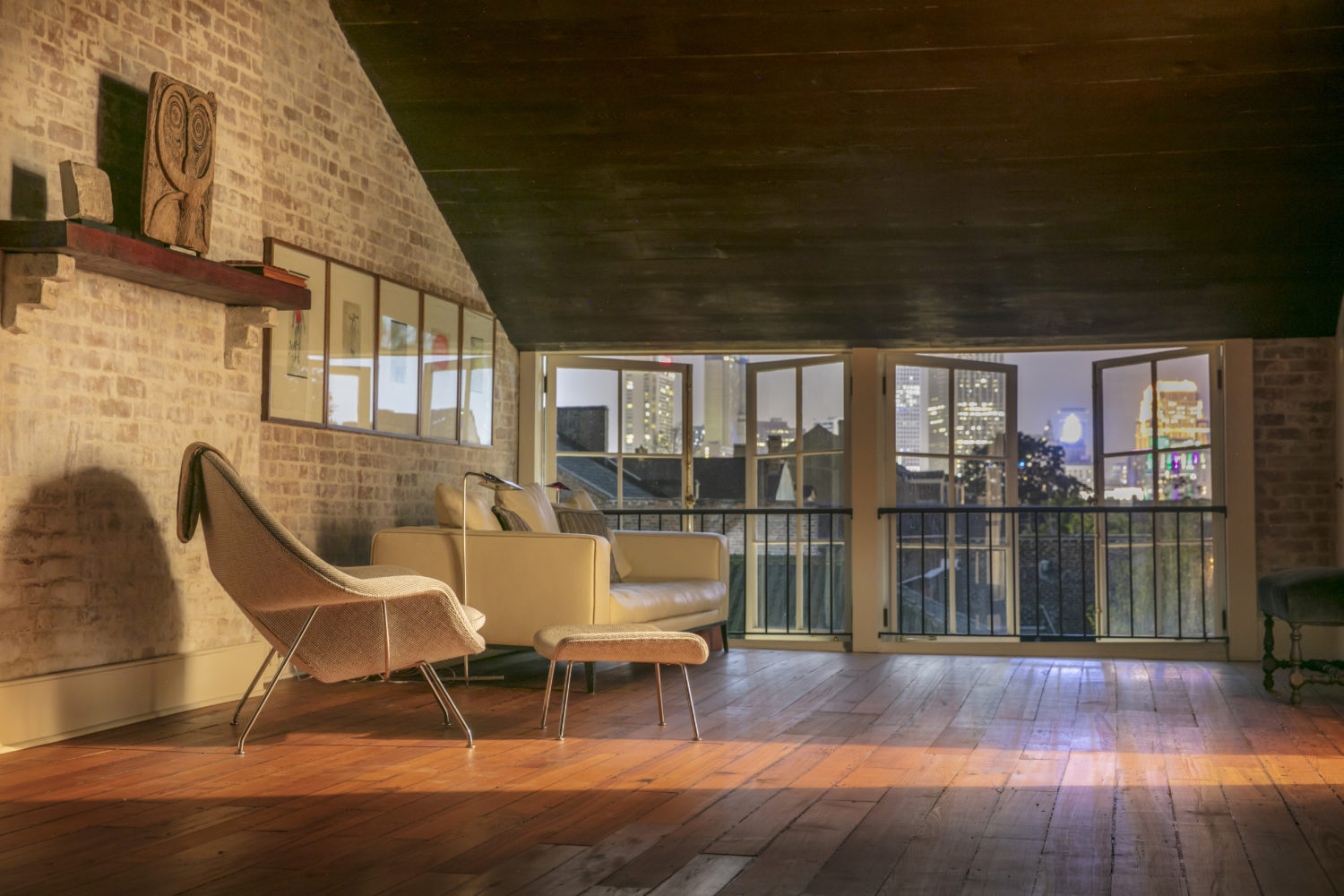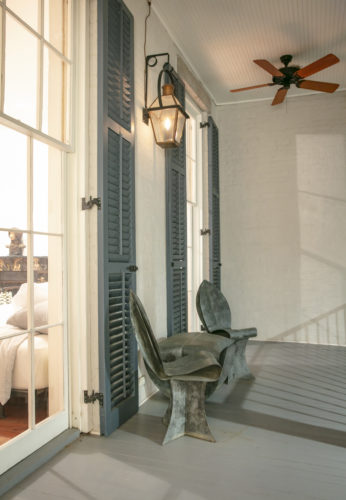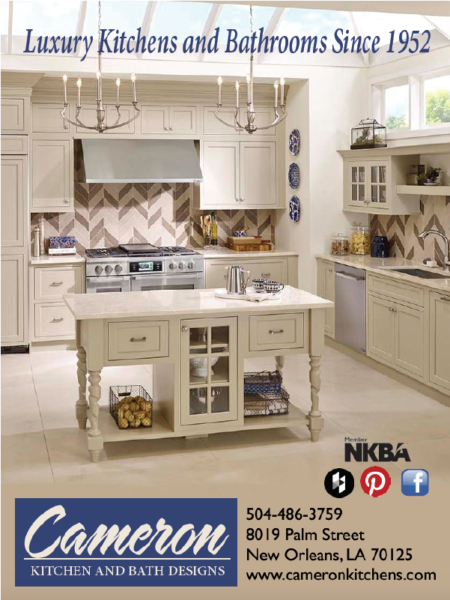This story appeared in the April issue of the PRC’s Preservation in Print magazine. Interested in getting more preservation stories like this delivered to your door each month? Become a member of the PRC for a subscription!
Betsy Eberle Fifield’s passions have long been focused on food — particularly sustainably harvested, locally grown, biodynamic agriculture. She grew up in a farming community in Wisconsin, worked to improve school lunches in Colorado by creating the Children’s Health Foundation, and drew attention to the importance of eating local by founding Locavore USA.
Meanwhile, down in New Orleans for the past four years, Fifield has been lovingly restoring an approximately 185-year-old Greek Revival-style American townhouse on the edge of the French Quarter. At some point, early in the process, it dawned on her: many of the sustainable practices she’d learned in agriculture could be applied to architecture.
As the work began on her home, Fifield gave the project an overall imperative: the building would be as sustainable and healthy as possible, and all work would be guided by the Department of the Interior’s Standards for the Treatment of Historic Properties. She would strive, when possible, to use local materials, traditional building methods, local craftspeople and to be environmentally sensitive.
Advertisement
“I didn’t set out to say I am going to have a sustainable house,” said Fifield, who utilized historic rehabilitation tax credits for the project. “I said, ‘This house will reflect everything that I think is important, such as how do we get the cleanest air, how do we get the sounds right.’ ”
When it was still under construction, Fifield’s home was featured in a 2017 Preservation in Print article and in a PRC Beams & Brews event. Now that the renovation is largely complete — though Fifield still is working on the kitchen’s design and hasn’t begun furnishing the home yet — it’s a good time to check in with her to see how historic preservation methods helped her create an environmentally sensitive home.
“To me, luxury is creating a sanctuary in the French Quarter,” Fifield said. “I wanted a stripped back home, uncluttered, functional, serene, that smells of lemon from the neighboring Magnolia trees in May; the sound of the falling water from the original fountain; the croaking frogs trolling for a partner; the birdsong of the turtle doves returning to my porch. All of this landscape and the sounds of life echoing in my courtyard could have been lost. By using sustainable systems, you can hear again natural sounds that the old-style mechanical systems would have drowned out.”
This spring, the PRC is hosting a series of events focused on issues related to climate change and historic preservation.
 Light from the hallway casts long shadows into the third-floor living room. The room serves as Fifield’s personal retreat, art studio and yoga space. The windows offer a panoramic view of the French Quarter rooftops and the Central Business District skyscrapers. Photo by Chris Granger.
Light from the hallway casts long shadows into the third-floor living room. The room serves as Fifield’s personal retreat, art studio and yoga space. The windows offer a panoramic view of the French Quarter rooftops and the Central Business District skyscrapers. Photo by Chris Granger.
Historic bones
Like many modern homeowners today, Fifield can control almost every mechanical system in her house — lighting, security, temperature, speakers, fans — with just a touch of a button on her phone. But what’s more remarkable than the property’s highly energy-efficient technology is the fact that it’s virtually invisible in a house built in the 1830s by William Montgomery, a businessman who served under Andrew Jackson in the Battle of New Orleans.
During the nearly two centuries that it has stood on Esplanade Avenue, the property has evolved with the generations, conforming to meet its various owners’ needs. When Fifield bought it in 2015 — after reading about it in a New York Times real estate listing — the three-story, 4,965-square-foot house had been carved up into five apartments. The grand side hall was painted a tangerine hue, and the first-floor double parlors were divided into living space, a kitchen and bathroom.
In various spots, ceilings had been furred down to accommodate duct work and wiring, and many of the home’s original architectural elements had been covered over or altered.
Working with partner and local contractor Andy Scott and with architect Daniel Zangara, Fifield began an extensive three-year renovation to strip away decades of changes and restore the property to its original grandeur as a single-family home.
During the demolition, Fifield and Scott removed walls and finishes from more recent eras, and, like reading tree rings, started to uncover the home’s original design. To help with that process, Fifield brought in Cypress Building Conservation, which conducted a materials analysis to determine the original floorplan, the original interior and exterior finishes, and to chronicle the property’s history.
Advertisement
As the demolition unfolded, the original lines of the house began to reveal themselves. Graceful curves in the staircase, original to its construction, were uncovered under layers of plaster. Nine fireplaces, most of them still operable, were revealed, though some of the mantels were missing and would need to be replicated.
“We were essentially doing a forensic analysis on the house to determine what happened and what was done right, what’s original and what’s not,” said Zangara, adding that Fifield instructed him to “be innovative and to push the limits to be sustainable.
The goal was to add modern equipment, electrical and mechanical systems, while preserving the volume of these big spaces,” he said. To avoid lowering ceiling heights to mask pipes, wires and ducts, for example, Zangara and Scott worked with HVAC technician Raul Mena of Mena Air Conditioning and Heating to widen the wall between the front and back parlors to allow a duct to maneuver below the ceiling joist.
To fit an elevator into the building, the wall along the side hall was thickened to two feet, which created space for the elevator shaft, mechanical closets, ducts and pipes while also creating a vestibule-like passageway between the parlor and the hall.
At the second-floor double parlour, which was to become the master suite, instead of carving the back parlor up into a dressing room and bathroom, Fifield and Zangara expanded the front parlor, re-imagining it as a gracious sitting/dressing room. To accomplish this dual feat, minimalist armoires were floated in the space, giving definition to the dressing area while allowing the light-filled historic volume to remain intact.
19th-century architecture meets 21st-century technology
One of the most critical decisions of the renovation was the choice to install a highly energy-efficient geo-thermal heating and cooling system coupled to a geo-exchange loop field under the courtyard. To accommodate the system, wells were drilled deep underground, a feat that required a custom drill rig created by Mena to navigate tight spaces in the French Quarter.
There are multiple benefits of the geo-thermal system: it provides excellent dehumidification and cooling in the summer and equally efficient heating in winter. This is an important advantage in an older building because it can compensate for the limitations of a structure that should not be sealed and insulated to modern standards, as the building materials need to breathe. It also translates into more compact indoor equipment, all of which allow the historic fabric of the building to take center stage while the technology fades discretely into the background.
Geo-thermal exchange systems use about 25 to 50 percent less electricity than a conventional HVAC system, according to the U.S. Department of Energy. “Geothermal heat pumps can reduce energy consumption — and corresponding emissions — up to 44 percent compared with air-source heat pumps and up to 72 percent compared with electric resistance heating with standard air-conditioning equipment,” according to the U.S. Department of Energy at www.energy.gov. Geo-thermal heat pump systems “also improve humidity control by maintaining about 50 percent relative indoor humidity, making (the systems) very effective in humid areas.”
Under the courtyard’s original brick — which was removed for the installation of the system and then put back in its original herringbone pattern — the home’s heating and cooling loop field is completely hidden. “Nobody would ever suspect 300 feet below ground lies a geo-thermal exchange system that brings so much luxury to my life,” Fifield said.
There also was another advantage particularly important to Fifield: the system is whisper quiet. With no bulky and noisy outdoor condensers clicking off and on, the courtyard is filled with more natural noises. “I hear turtle doves nesting on the second floor. I hear the frogs in the fountain,” she said. “My goal always was to not only restore this house, but also to make sure it breathed well, smelled right and sounded right.”
To further improve the energy-efficiency of the house, Fifield and Zangara explored the idea of installing solar panels. But since the panels could have been seen from the street, they decided against it to be in keeping with the historic character of the neighborhood.
Advertisement
With such an old house, it was essential to ensure the “breathability” of the exterior masonry walls. So Zangara worked with building envelope consultant George Ferris of Alternative Energy Sources to design appropriate insulation.
At sun-exposed walls, a radiant barrier was installed to transfer incoming heat, increasing the home’s energy efficiency while also allowing it to breathe. Instead of spray foam insulation at the roof line, Ferris recommended a formaldehyde-free, high-density, “cathedral” batt to be used with a layer of radiant barrier and a one-inch air gap between them, effectively creating a heat shield where the building is most exposed to hot summer sun. Like with the walls, this helps the home with climate control and energy efficiency in a simple, low-tech way.
“In the main structure on the third floor, we used a sustainable product called EcoBatts. The product is manufactured from 61.9 percent post-consumer materials,” Ferris wrote in an email explaining the approach. “There’s no kraft paper backing on the product, which does not support microbial growth. The product is Greenguard certified.”
Unfaced EcoBatts insulation “allows the wood and other components of the structure to expand and contract naturally with the changes in temperature,” Ferris wrote.
On the roof line, Ferris installed the EcoBatts inside the rafter cavities. A polypropylene mesh net material was then installed “to force back some of the EcoBatts insulation to create a three-quarter-inch to one-inch void. The purpose of this was to allow the installation of the radiant barrier over the surface of the roof rafters to cover the void. This allows the use of the natural properties of the void to serve as an insulator,” Ferris wrote, adding that “the radiant barrier is perforated, which minimizes the possibility of condensation.”
Here, on the third floor under the cathedral ceiling, the building eschews the formality of the main floors below. By employing an open plan layout, it becomes a more direct expression of timber frame construction and enclosure, an informal counterpoint to the more staid rectangular volumes below. Under a vaulting roof line set atop low frieze windows, Fifield has made perhaps her most personal statement in the house: a sanctuary at once inspiring and intimate, perfect for creative work and informal entertaining.
Fifield’s environmentally sensitive approach also extended to other elements of the house. Throughout the property, for example, she used energy-efficient and water-saving natural gas tankless water heaters.
The renovation of the house’s main kitchen, located in the original kitchen space in the dependency on the first floor, is not complete yet. The third floor, pictured here, has a bright, white mini-kitchen. A full bathroom is behind the kitchen. Photo by Chris Granger.
She also turned to time-tested “green” historic preservation methods, such as refurbishing the original wood windows and doors instead of replacing them, and restoring the original pine floor with a natural finish that consists of tung oil and beeswax, trading high gloss for texture and tactility.
For the interior walls, Fifield opted for traditional Venetian plaster. Master plasterer Jeff Poree used a two-coat resurfacing technique with a Venetian plaster troweling finish. Purposefully left uncolored, the walls are luminous. All told, the experience of the building is of unfussy simplicity; crisply defined spaces that allow plaster and wood and stone to take center stage.
Much of the marvel of the house is what’s not seen. Standing in the first-floor front parlor, Zangara pointed out the discreet — almost invisible — ways modern technology is blended into the historic architecture. The chameleon-like air conditioning vents on the first floor are stained the same color as the wood floors, making them almost unnoticeable. Small recessed lights are left untrimmed in the ceiling, so they don’t draw the eye, and all electrical outlets are on the baseboards, so as not to obstruct Poree’s gorgeous plaster work.
As Fifield recently showed visitors around the house, the music of Jackson Browne played softly in the background. Looking around, though, there were no signs of speakers.
“They’re mudded over in the walls,” Zangara said. “They’re called Stealth (Acoustics) speakers.”
Fifield smiled as Zangara mentioned the concealed speakers. “I’m living a very contemporary lifestyle in a very historic structure,” she said, “and I wake up every day and think, how did I get so lucky?’”
Click images to expand. Photos by Chris Granger.
Advertisements

























